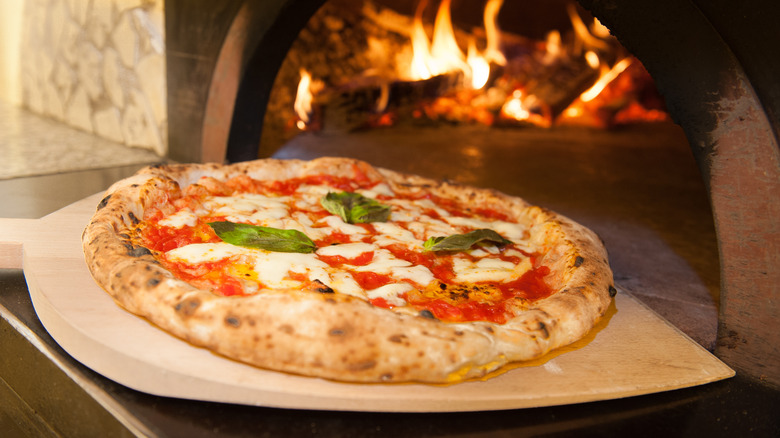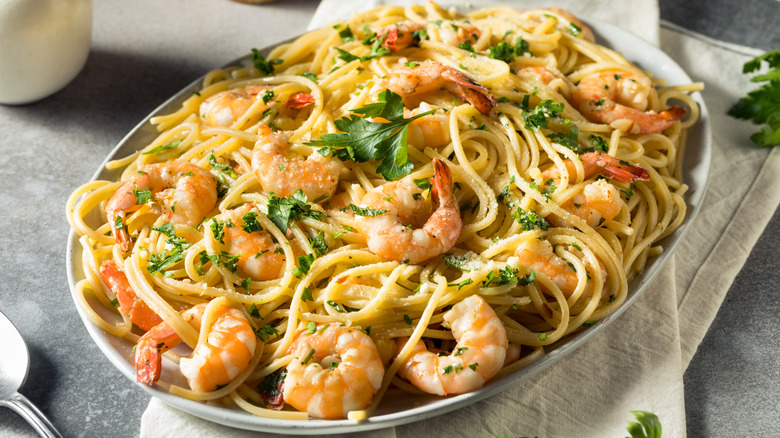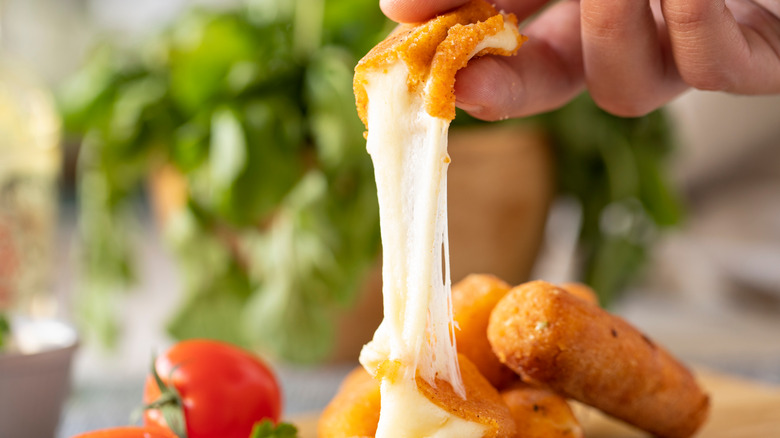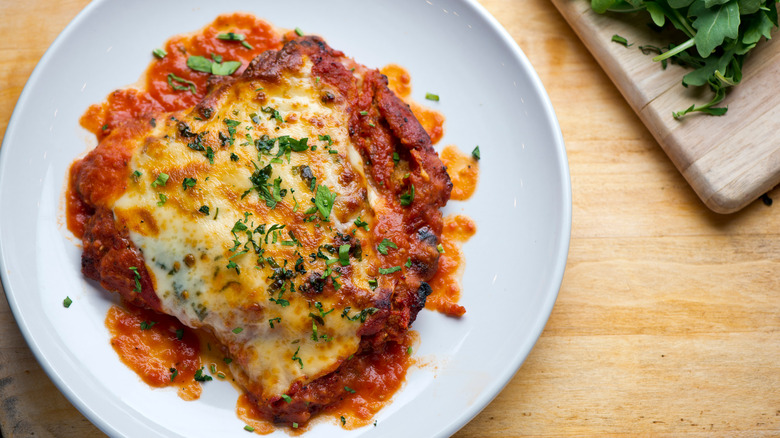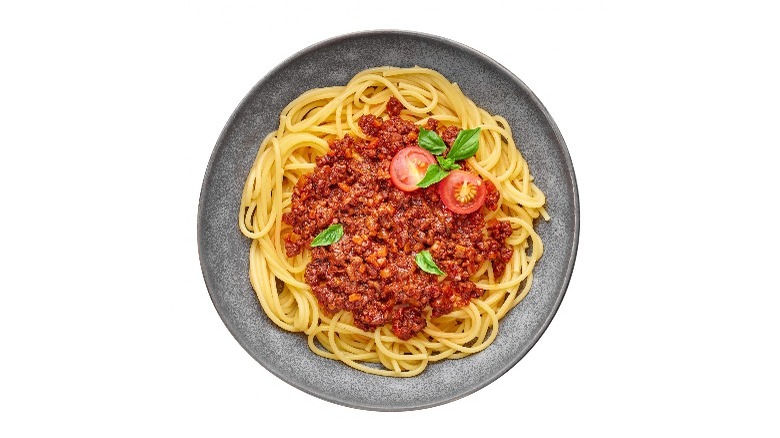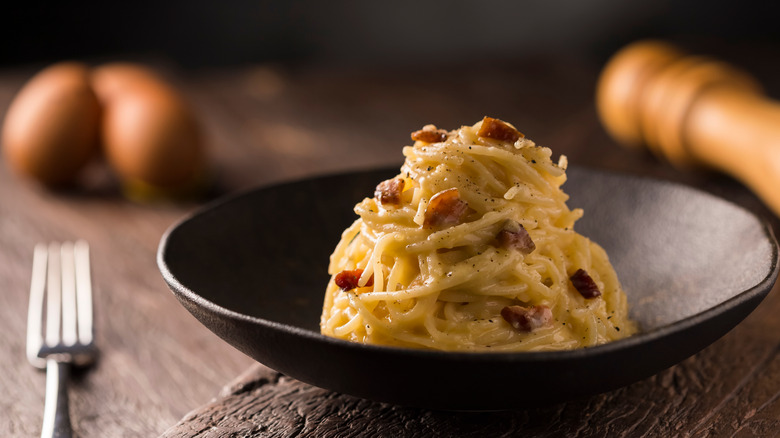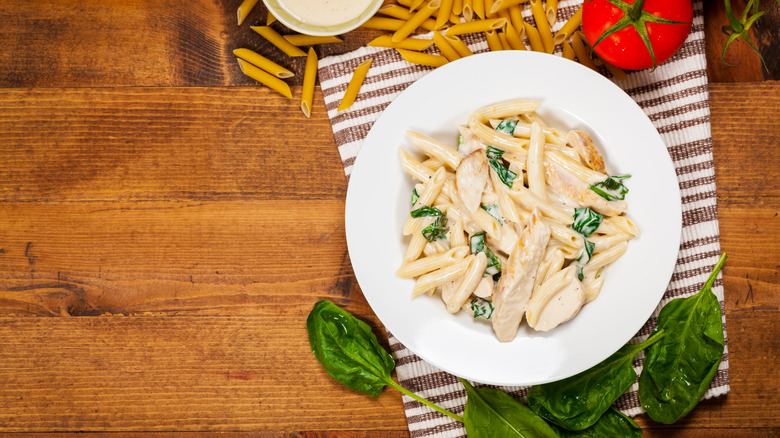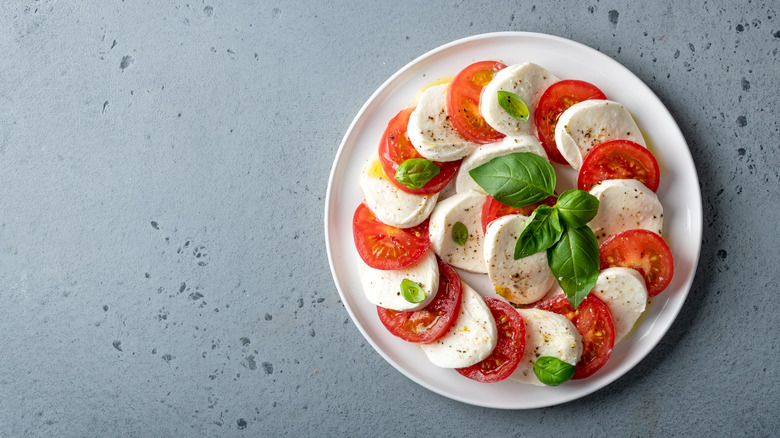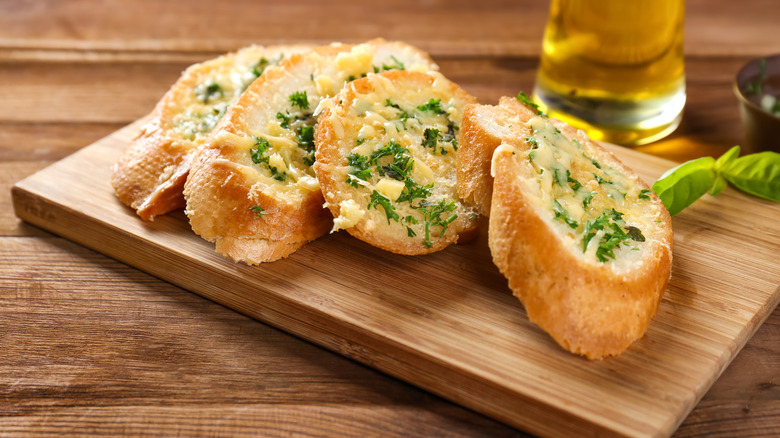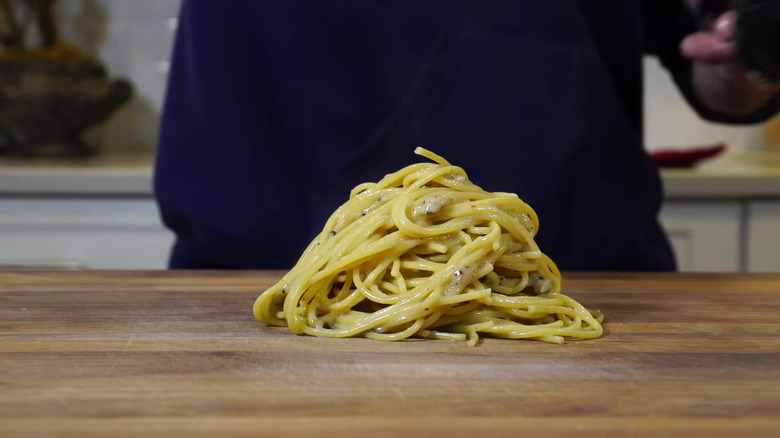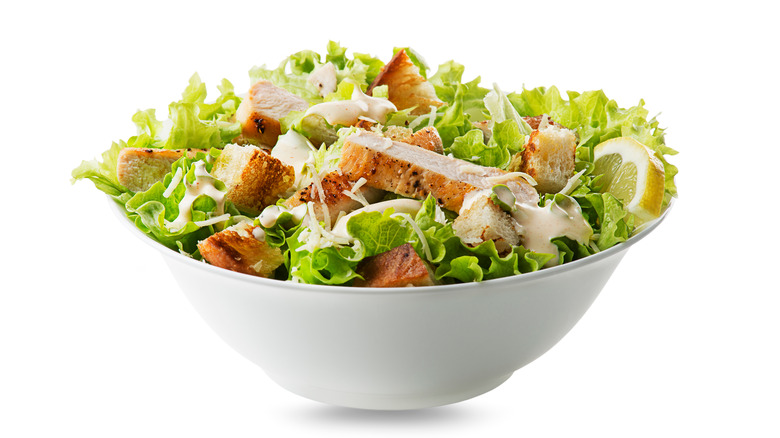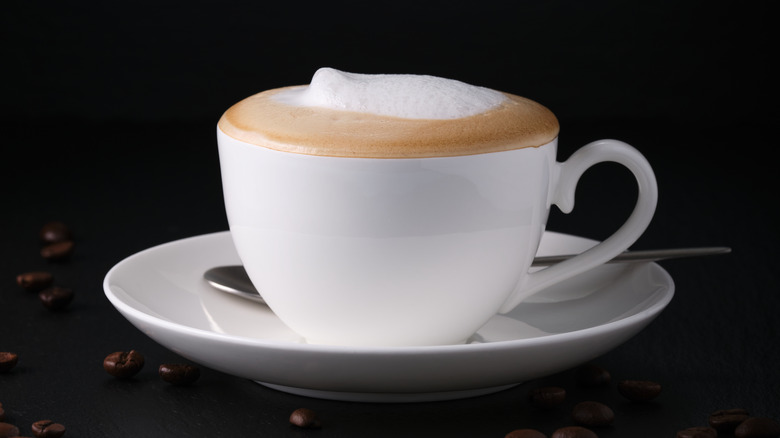Here's What Chefs Say You Should Avoid Ordering At Italian Restaurants
In 2019 YouGov reported that Italian cuisine was the most popular in the world, receiving an overall approval score of 84% after being rated by 25,000 people in 24 different countries. The same study found that Americans especially enjoy the cuisine, giving it a rating of 88%. This score is likely due to Americans' long-felt affinity for Italian cuisine, which can likely be credited to the many Italian nationals who moved to America during the 19th and 20th centuries (per Library of Congress).
In America, not all Italian cuisine is enjoyed from the comfort of home. Quite to the contrary, a 2016 estimate by National Geographic suggested that as many as one in eight of all American restaurants at the time served Italian food. However, not all of the dishes served at these restaurants are authentically Italian, and some, if you ask chefs, are not worth ordering at all.
The reasons for this are varied, including cost, taste, and tradition. And while Americans may not think they need advice on how to order Italian food, the statistics would say otherwise. YouGov highlighted that America, along with the rest of the world, is accused by Italians of committing nearly 20 "crimes" against the cuisine, from eating garlic bread with pasta to having cheese on seafood pasta. So, maybe it's time to take the culinary experts' advice. There's no better way to start than by avoiding ordering these disappointing dishes when you next visit your favorite Italian restaurant.
Margherita pizza
Pizza is perhaps Italy's most loved culinary export, it being the world's most popular take-out dish (per Money Beach). In America, it is hard to escape the sight or smell of pizza; South Florida Reporter highlighted that the USDA reports 13% of Americans eat pizza every day, while The Washington Post revealed that per day, Americans combined eat 100 acres of pizza. The dish is clearly an American favorite, so why on Earth do chefs say you shouldn't order perhaps the most iconic pizza of all, the Margherita?
It boils down to cost. The same short ingredient list — tomato sauce, mozzarella, basil — that makes the pizza such a crowd-pleaser also means Margheritas are notoriously cheap to make. In other words, it's not great value for money, as chef Julia Helton illustrates, per an Insider interview: "Dough, a little sauce, a quarter of a log of mozzarella, and four pieces of basil. That's your dinner? You're paying $12 minimum for a dish that costs $1 to make. I know because I was the executive chef at an Italian restaurant for three years, so I worked out the cost many times. Stop paying for this dish." Instead, it's advised that customers should pick a pizza with more elaborate toppings or one that best highlights the flavors of wood-burning ovens.
Shrimp scampi
Seafood and pasta are a combination that everyone can get behind, Americans and Italians alike. As such, you would think dishes like shrimp scampi — where shrimp is combined with butter, garlic, chili, and pasta — would pose little controversy. However, the prevalence of the second ingredient, garlic, leads many chefs to avoid ordering shrimp scampi and quite a few other dishes made in Italian American restaurants.
As The Globe and Mail highlights, perhaps the biggest difference between Italian cuisine in Italy and Italian cuisine in America is the huge discrepancy in garlic use. Americans overuse the allium to such an extent that it drives many Italians living in America to despair (via The Guardian). Chefs are no different, believing that garlic can overpower many other ingredients, especially delicate-tasting seafood. As chef Barbara Pollastrini told Insider, instead of smothering shrimps with garlic: "Why not make the shrimp simply poached with extra-virgin olive oil, parsley, good white wine, and salt and pepper? I would be more than happy with it just like that."
Mozzarella sticks
While some people might enjoy the crunchy, cheesy mouthful of a mozzarella stick, chef Sedona Kusler is not among them: "I have the cynical view that most restaurants are just buying frozen breaded mozzarella sticks and throwing them in their deep fryer, and I don't like to pay for something I could prepare in my air-fryer at home" (via Eat This, Not That!). Not only are mozzarella sticks generally a low-quality, poor value-for-your-money option when eating out, but they are also not an accurate reflection of Italian cuisine at all.
Thrillist notes that, instead of Italy, the first written record of mozzarella sticks actually comes from France in a book called "Le Menagier de Paris," which was written in the 14th century. Despite this fact, Dr. John Gennari, a professor at the University of Vermont, stated to the same publication that: "Mozzarella sticks will always be considered 'Italian' because it uses an Italian cheese, and the word itself — mozzarella — will always bring up that Italian connotation. But they're not Italian."
Mozzarella sticks, and other greasy deep-fried dishes, also give Italian cuisine the reputation of being fatty and unhealthy, Kusler complains. This is far from the reality of authentic Italian cuisine, which prioritizes simplicity, seasonality, and freshness, as per The Italian Kitchen.
Chicken parmigiana
As reported by La Cucina Italiana, eggplant parmigiana is a true Italian classic, originating sometime before the mid-18th century, as attested to by its inclusion in the cookbook "Cuoco galante. By comparison, chicken parmigiana is a decidedly Italian-American dish, created by Italian immigrants living in America during the 20th century, as per The New York Times. The dish's short history has done nothing to limit its popularity; chicken parmigiana is now a staple dish across America and even features on pub menus all over Australia (via ABC News).
However, chefs — especially those with Italian heritage — are not impressed. A stance epitomized by Michael DeLone, owner of Nunzio Ristorante Rustico in Philadelphia. As DeLone told Eat This, Not That!, "The truth is that despite many people looking for chicken parmesan at my restaurant, there are way more authentic, creative, and fundamentally Italian dishes I want to prepare. Any restaurant just offering chicken parm falls in a certain category for me (and not in a good way), so I know where to set my expectations." While DeLone does not specify which type of restaurants he means, we can all hazard a guess thanks to another chef, Phil Pretty, who stated to Salon that he avoids ordering chicken parmigiana as it is nearly always frozen before being reheated to order. In other words, chicken parmigiana brings to mind less-than-stellar culinary practices.
Spaghetti bolognese
Despite being a stalwart of Italian American cuisine, spaghetti bolognese is something you should probably avoid ordering when treating yourself to a meal out. We make this suggestion for a number of reasons. Firstly, as chef Aleka Shunk pointed out to Insider, spaghetti bolognese is not difficult to cook yourself, and the difference in the final quality of your dish versus one cooked in a restaurant will most probably be negligible. What's more, the cost of eating spaghetti bolognese in a restaurant is much more than making it yourself.
Chef Michael DeLone makes another valid complaint which, while aimed at spaghetti and meatballs, is as valid for spaghetti bolognese: "For me, most Italian-American restaurants drown their food in whatever sauces they are dousing the pasta with – tomato, carbonara, alfredo, etc. This is not the best representation of Italian cuisine — cover it with sauce and call it a day" (via Eat This, Not That!).
Finally, Insider reports that while a beloved dish in America, spaghetti bolognese doesn't even exist in Italy. A bold statement made by none other than Virginio Merola, the mayor of Bologna. Instead, residents of Bologna are known to enjoy tagliatelle al ragù, a similar dish, albeit served with a different sauce and thicker strands of pasta.
Pasta alla Carbonara
When done right, pasta alla carbonara is a wonderfully simple yet incredibly flavorful dish. Traditionally it is made with raw eggs, spaghetti, Pecorino Romano, guanciale, and ground black pepper, as per La Cucina Italiana. However, there is no guarantee that this, the original version of carbonara, is what you will be served in restaurants outside of Italy, with two alterations frequently being made in America. These are the dubious use of heavy cream to make the sauce — a crime even Martha Stewart has been accused of (per Insider) — and the inclusion of peas, both of which raise concerns for chefs such as David Kirschner: "Anytime a carbonara is served with peas, it is usually a red flag that you aren't getting the classic Roman carbonara cooked the way it is supposed to be. No cream or peas should be anywhere near the dish at all. Just egg yolks and grated cheese make this dish the perfect creamy pasta that it is supposed to be" (via Eat This, Not That!).
It is not just the risk of erroneous ingredients being included that lead many to avoid ordering carbonara but also concerns about the quality of the product in general. As such a simple dish, carbonara relies on great ingredients to bring vast amounts of flavor; otherwise, it runs the risk of being bland. Consequently, many, including the indomitable Stanley Tucci, swear on never ordering the dish outside of Italy or even Rome itself (per Insider).
Chicken Alfredo
Unlike a lot of dishes on this list, fettuccine all'Alfredo is an authentic Italian dish invented by Alfredo Di Lelio during the early part of the 20th century, as per Forbes. The egg-heavy pasta is served in a luscious sauce made from Parmigiano Reggiano and the richest butter available. Forbes notes that the dish proved immensely popular with Italians and American tourists when it was invented, with fettuccine all'Alfredo consequently being brought to America. Here, however, the troubles begin. Unfortunately, many of the vital foodstuffs used to make fettuccine all'Alfredo were unavailable in the United States during the first half of the 20th century. Substitutions, including cream and parsley, were habitually made, and even chicken got added. Thus, we ended up with the often gloopy, bland, American specialty, chicken Alfredo.
Perhaps unsurprisingly, this version of Alfredo does not impress chef David Kirschner: "Alfredo is also something I typically avoid. The price that is usually charged for this is obscene, knowing that it is simply reduced cream with grated cheese and butter. Then most places throw some grilled chicken on it that is usually sliced so thin it has no moisture left in it when cooked. Nine out of 10 times, it's a disappointing dish that congeals into a ball by the time you get through eating half of it" (via Eat This, Not That!).
Caprese salad
Caprese salad is a wonderful mix of sliced tomatoes, mozzarella, basil, and olive oil (via La Cucina Italiana). It is, without doubt, a wonderful study in simplicity, one that is adored in Italy, America, and beyond. However, the dish comes with one huge caveat; it relies on ripe, flavorsome, and seasonal tomatoes for the vast majority of its flavor. A fact that many restaurants ignore, according to chef Natale Servino's comments to Insider: "Caprese salad is a dish that you will find on a menu at an Italian restaurant year-round, as it is always a great seller. However, more often than not, the tomatoes will be out of season and lack flavor. Only order this dish if tomatoes are in season. Otherwise, skip it."
As Salon reports, the beefsteak tomato is most commonly used when making Caprese salad thanks to its large size, firm texture, and agreeable flavor. These typically come into season sometime around July and last until September (via Good to Know). So, feel free to order Caprese salad during these summer months, but it's probably wise to avoid the salad during winter.
Garlic bread
Originating from the Italian classic, bruschetta, garlic bread has become an Italian American classic, with 61% of the American populace labeling it as their favorite bread when eating out (via Bake). But while it is a common feature of menus across the United States, you would be hard-pressed to find one that chefs believe is worth ordering.
The reasons for this are two-fold. The first is that the bread itself is probably low-quality, as Natale Servino explained to Insider: "If the restaurant has to hide the flavor of its bread with butter and garlic, you should probably skip it. Look for fresh, homemade, or locally made bread that doesn't have to be covered in butter and baked in order to taste good."
Furthermore, the association between dishes like garlic bread and Italian cuisine is damaging. Many Americans believe that the cuisine is inherently stodgy, fatty, and unhealthy, which isn't the case, as chef Sedona Kusler described: "I think Italian food is often seen as unhealthy because of items like fried cheese and garlic-butter-soaked bread, which, don't get me wrong, usually tastes delicious, but I don't love the way it represents Italian food to the masses" (via Eat This, Not That!).
Cacio e pepe
Another simple stalwart of Italian kitchens, cacio e pepe, is a fast, easy-to-make meal that uses just three ingredients, spaghetti, Pecorino Romano, and black pepper (via BBC). As with the Margherita pizza, the main argument against ordering cacio e pepe is nothing against the dish itself but rather the cost. To put it simply, eating cacio e pepe in a restaurant is astronomically more expensive than making it at home. What's more, the cooking process only takes a handful of minutes, as highlighted by Linda Harrell: "Cacio e pepe isn't worth the money. In Italy, this dish is made when someone has no time to make a decent sauce. It's something made for a quick meal, not a restaurant dish" (via Insider).
For some, the idea of paying full price for such a simple dish is blasphemous. This, however, is a matter of opinion. The late Anthony Bourdain was known to frequent restaurants in Rome in order to eat this Italian specialty. While La Cucina Italiana notes that a chef's skill can transform the dish, mainly by acquiring the perfect cremina. So, while ordering cacio e pepe may not make economic sense to some people, the experience will still be worth it.
Caesar salad
It is fair to say that chef Barbara Pollastrini has no time for Caesar salad: "The Caesar salad has nothing to do with Julius Caesar or Rome. We'd never serve mayonnaise on lettuce in Italy. The Caesar salad was originally made in Mexico by an Italian immigrant who lived in Tijuana" (via Insider). This claim is validated by BBC, highlighting that the now-famous salad was invented by an Italian man called Caesar Cardini on America's Independence Day in 1924. BBC goes on to report that it only took till the 1940s for the dish to have reached widespread acclaim across the United States, a position it has held, albeit slightly tenuously, ever since.
One of the main reasons that the dish has never been accepted by some chefs, especially those with Italian heritage, is because the salad — especially when it is served with chicken — doesn't fit into the traditional Italian meal structure. As Italian Garden notes, traditionally, salad is served after the main course as a palate cleanser and digestive aid. Of course, a mound of heavily dressed, cheese and chicken-laden Caesar salad is nobody's idea of a light palate cleanser, and as such, has no place in the cuisine.
Cappuccino
Cappuccinos are adored the world over for their frothy texture and feature on just about every cafe's menu. So, why shouldn't you order a cappuccino from an Italian restaurant? The answer is simple: a cappuccino should only be enjoyed in the morning as breakfast, not in the afternoon, and never after eating. Once again, Barbara Pollastrini explains: "What, for us, is the ritual of the most classic Italian breakfast — a croissant and a cappuccino — for Americans is a drink to be enjoyed after lunch like a coffee. Absolutely no. It would be like ordering a cup of cold milk and cornflakes after a meal" (via Insider).
As HuffPost reports, the drink is deemed too heavy to enjoy in the afternoon or after eating, thanks to the high volume of milk it contains. If an afternoon hit of caffeine is required, Italians will instead turn to a simple espresso. However, variations such as a macchiato or cortado are also deemed acceptable.

